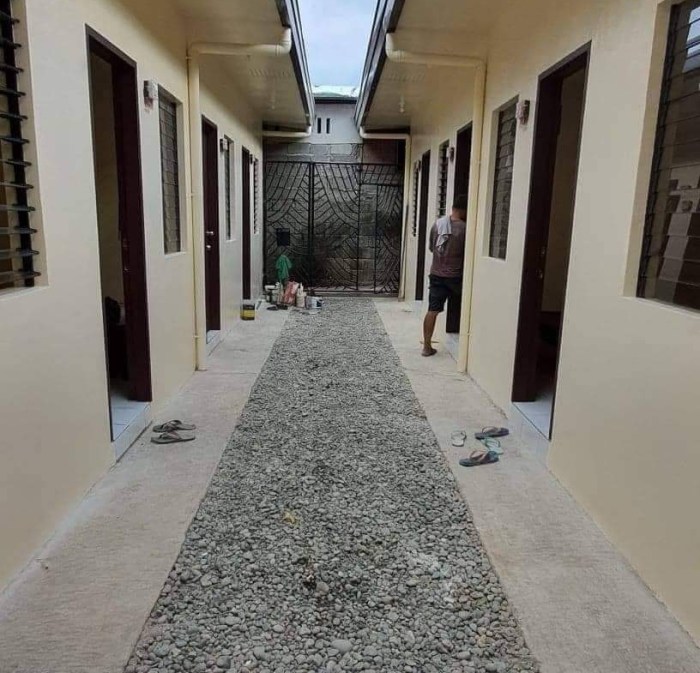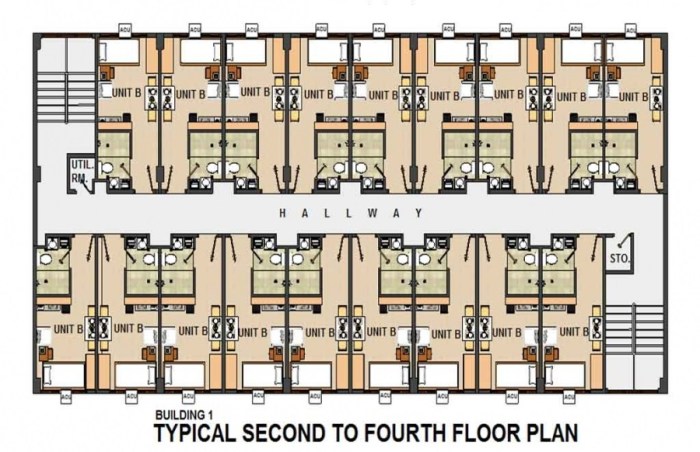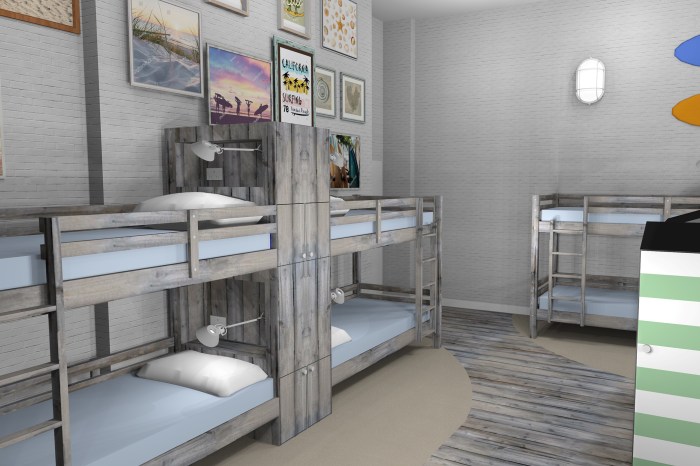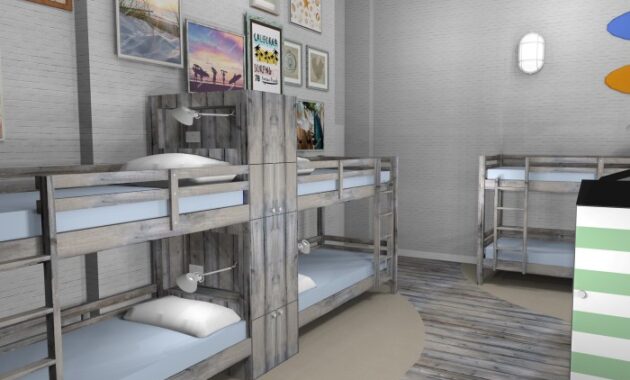Boarding house interior design in the Philippines is a fascinating blend of practicality, cultural influences, and a desire to create welcoming and comfortable spaces for residents. The Filipino boarding house culture is deeply rooted in tradition, with a strong emphasis on community and shared living.
This unique context shapes the design preferences and expectations of boarders, influencing everything from the layout and furniture choices to the use of color and decorative elements.
This guide explores the key considerations for designing boarding houses in the Philippines, covering aspects like space planning, aesthetics, comfort, safety, sustainability, budget-friendly solutions, community building, and future trends. We delve into the specific needs and preferences of Filipino boarders, providing practical advice and inspiring examples to help you create a successful and enjoyable living environment.
Comfort and Convenience: Boarding House Interior Design In The Philippines

A boarding house should be a haven of comfort and convenience for its residents. After all, it’s their home away from home, and they deserve a space that feels welcoming and functional.
Comfortable Bedding and Seating Arrangements
Creating a comfortable and inviting atmosphere starts with the essentials – comfortable bedding and seating arrangements. Good quality mattresses, pillows, and bedding are crucial for ensuring a good night’s sleep.
- Consider investing in memory foam mattresses or orthopedic pillows for added support and comfort.
- Provide ample storage space for linens and personal belongings.
Similarly, comfortable seating arrangements are essential for relaxation and socializing.
- A variety of seating options, including armchairs, sofas, and beanbags, can cater to different preferences.
- Ensure adequate lighting in common areas for reading and socializing.
Practical and Stylish Lighting Solutions
Lighting plays a crucial role in setting the mood and functionality of a space. A well-lit boarding house promotes a sense of safety, comfort, and productivity.
- Install bright overhead lights in common areas like the kitchen and dining room for optimal visibility.
- Use softer, ambient lighting in bedrooms and living areas to create a relaxing atmosphere.
- Consider using energy-efficient LED bulbs to reduce energy consumption and save on electricity bills.
Creating a Sense of Privacy and Personal Space
While boarding houses often involve shared spaces, it’s essential to create a sense of privacy and personal space for each resident.
- Utilize room dividers or curtains to create distinct zones within shared rooms.
- Provide individual storage units or lockers for each resident to store their personal belongings.
- Encourage residents to personalize their spaces with artwork, plants, or other decorative items.
Sustainability and Eco-Friendly Design
Sustainability and eco-friendly design are becoming increasingly important in the Philippines, as the country faces the challenges of climate change and resource scarcity. Boarding houses, as essential components of the housing landscape, can play a significant role in promoting sustainable practices and reducing their environmental footprint.
Boarding houses in the Philippines often reflect a blend of practicality and aesthetics. While functionality is key, incorporating elements of charm can enhance the experience for residents. One inspiration for this can be found in the 1950 house interior design style, known for its use of warm colors, natural materials, and classic furniture pieces.
This approach can create a welcoming and comfortable atmosphere, perfect for a shared living space.
By incorporating sustainable materials, energy-efficient appliances, and green building practices, boarding houses can create a more environmentally responsible and cost-effective living environment for their residents.
Sustainable Materials
The use of sustainable materials is a crucial aspect of eco-friendly design. Sustainable materials are those that are sourced responsibly, have minimal environmental impact during production, and are durable and long-lasting. Here are some examples of sustainable materials that can be used in boarding house interiors:
- Bamboo:Bamboo is a fast-growing, renewable resource that is naturally strong and durable. It can be used for flooring, furniture, and even structural elements.
- Recycled Plastic:Recycled plastic can be used for various applications, including flooring, furniture, and wall panels. It reduces plastic waste and provides a durable and cost-effective option.
- Locally Sourced Wood:Using wood from sustainable forestry practices helps to support local economies and minimize the environmental impact of wood harvesting. Consider using reclaimed wood for furniture and decorative elements.
- Natural Stone:Natural stone, such as granite, marble, and limestone, is a durable and aesthetically pleasing material. Ensure that the stone is sourced responsibly and has minimal environmental impact.
Energy-Efficient Appliances
Incorporating energy-efficient appliances is essential for reducing energy consumption and lowering utility bills in a boarding house. These appliances are designed to use less energy while providing the same level of performance. Here are some examples of energy-efficient appliances:
- LED Lighting:LED lights use significantly less energy than traditional incandescent bulbs while providing bright and long-lasting illumination.
- Energy-Efficient Refrigerators:Modern refrigerators with energy-efficient ratings consume less energy than older models. Look for refrigerators with features like automatic defrosting and adjustable temperature settings.
- High-Efficiency Washing Machines:High-efficiency washing machines use less water and energy than traditional models. They often have features like automatic load sensing and water-saving cycles.
- Energy-Star Rated Appliances:The Energy Star label is a recognized symbol of energy efficiency. Look for appliances that have earned the Energy Star rating to ensure they meet specific energy-saving standards.
Green Building Practices
Green building practices are a set of design and construction techniques that aim to minimize the environmental impact of buildings. These practices can be incorporated into boarding houses to create a more sustainable and eco-friendly living environment. Here are some examples of green building practices:
- Rainwater Harvesting:Collecting rainwater from rooftops and storing it in tanks can be used for watering plants, flushing toilets, and other non-potable water uses. This reduces reliance on municipal water supply and conserves water resources.
- Natural Ventilation:Designing the boarding house with cross-ventilation allows for natural airflow, reducing the need for air conditioning and improving indoor air quality. This can be achieved through strategic placement of windows and doors.
- Solar Water Heating:Solar panels can be installed on the roof to heat water using the sun’s energy. This reduces reliance on fossil fuels and lowers energy bills.
- Green Roofs:Green roofs are covered with vegetation, which helps to insulate the building, reduce stormwater runoff, and provide a habitat for wildlife. They can also improve the aesthetics of the boarding house.
Benefits of Sustainable Design
Incorporating sustainable design elements in a boarding house offers numerous benefits, including:
- Reduced Environmental Impact:Sustainable design practices help to minimize the environmental footprint of the boarding house by reducing energy consumption, water usage, and waste generation.
- Cost Savings:Energy-efficient appliances and green building practices can lead to significant cost savings on utility bills and maintenance costs over time.
- Improved Health and Well-being:Natural ventilation, access to daylight, and the use of non-toxic materials contribute to a healthier and more comfortable living environment for residents.
- Enhanced Property Value:Sustainable features can increase the value of the boarding house and make it more attractive to potential tenants.
Creating a Sense of Community
A boarding house is more than just a place to sleep; it’s a space where people come together, share experiences, and build connections. Creating a strong sense of community within a boarding house can significantly enhance the overall living experience for residents.
Designing Communal Spaces
A thoughtfully designed communal space serves as the heart of the boarding house, encouraging interaction and fostering a sense of belonging among residents.
- A Spacious and Inviting Living Room:A well-furnished living room with comfortable seating arrangements, a large television, and perhaps a fireplace or a cozy reading nook can become a hub for socializing and relaxation. This space can be used for movie nights, board game evenings, or simply catching up with fellow residents.
- A Fully Equipped Kitchen:A well-equipped kitchen that encourages residents to cook and share meals together can foster a sense of community. Providing a large dining table, a pantry stocked with basic essentials, and a designated space for food preparation can encourage interaction and collaboration among residents.
- Outdoor Spaces:A small garden or a patio can be a great addition to the boarding house, providing a space for residents to enjoy fresh air, relax, and socialize. A community garden where residents can grow their own herbs or vegetables can further promote interaction and shared interests.
Organizing Activities and Events
Hosting regular activities and events can bring residents together and create shared memories.
Boarding house interior design in the Philippines is often about maximizing space and creating a comfortable atmosphere for tenants. While affordability is key, a well-designed boarding house can attract more tenants and improve their overall experience. If you’re looking for inspiration on how to achieve a beautiful and functional interior, check out this website on the best design interior house.
The principles of good design, like maximizing natural light and using space efficiently, can be applied to any space, including a boarding house, to create a welcoming and stylish environment.
- Movie Nights:Movie nights are a classic way to bring people together. Residents can choose movies together, prepare snacks, and enjoy a fun evening in the communal living room.
- Game Nights:Board games, card games, or video game tournaments can provide entertainment and opportunities for friendly competition among residents.
- Potluck Dinners:Potluck dinners allow residents to share their culinary skills and cultural backgrounds while enjoying a delicious meal together.
- Themed Parties:Organizing themed parties, such as holiday celebrations or cultural events, can create excitement and provide opportunities for residents to dress up, socialize, and learn about different cultures.
- Volunteer Activities:Participating in volunteer activities as a group can foster a sense of purpose and unity among residents while giving back to the community.
Incorporating Elements that Promote Social Interaction
There are various design elements that can be incorporated to encourage social interaction within the boarding house.
- Open Floor Plans:Open floor plans in communal areas allow residents to see and interact with each other more easily, promoting a sense of openness and connection.
- Comfortable Seating Arrangements:Placing comfortable seating arrangements in strategic locations, such as near windows or in cozy corners, encourages residents to relax and engage in conversations.
- Shared Workspaces:Providing a designated shared workspace with desks, comfortable chairs, and good lighting can encourage residents to work or study together, fostering collaboration and interaction.
- Communal Bulletin Boards:A communal bulletin board where residents can post announcements, share information, or display their artwork can promote communication and create a sense of community ownership.
Future Trends in Boarding House Design

The Philippine boarding house landscape is constantly evolving, mirroring the dynamic shifts in the country’s urban landscape and the changing needs of its residents. As technology advances and lifestyles adapt, boarding houses are embracing innovative design strategies to create more comfortable, sustainable, and connected living spaces.
Integration of Technology
The integration of technology is poised to revolutionize the boarding house experience. This integration will enhance the comfort, convenience, and overall well-being of residents.
- Smart Home Automation:Boarding houses can incorporate smart home systems that allow residents to control lighting, temperature, and appliances remotely through mobile apps. This can enhance energy efficiency and provide greater comfort and convenience. For example, a resident can adjust the thermostat from their phone before returning home, ensuring a comfortable temperature upon arrival.
- Digital Security and Access Control:Boarding houses can implement digital security systems with keyless entry, video surveillance, and remote access control. This enhances security and reduces the reliance on traditional keys, promoting a safer and more convenient environment.
- High-Speed Internet and Connectivity:Providing reliable and high-speed internet access is crucial for residents’ work, study, and entertainment needs. Boarding houses can invest in robust internet infrastructure to cater to the increasing demand for connectivity.
Sustainable and Eco-Friendly Design
The demand for sustainable and eco-friendly living spaces is growing, and boarding houses are increasingly adopting green design principles.
- Energy-Efficient Appliances:Boarding houses can install energy-efficient appliances such as LED lighting, low-flow showerheads, and energy-star rated refrigerators to reduce energy consumption and utility costs.
- Water Conservation Measures:Implementing water-saving strategies such as rainwater harvesting, greywater recycling, and low-flow plumbing fixtures can significantly reduce water consumption and promote sustainability.
- Renewable Energy Sources:Incorporating renewable energy sources like solar panels or wind turbines can contribute to a greener and more sustainable boarding house experience. For example, a boarding house can install solar panels on the roof to generate electricity, reducing reliance on the grid and lowering energy bills.
Personalized and Flexible Spaces, Boarding house interior design in the philippines
The modern resident seeks personalized and flexible living spaces that cater to their individual needs and preferences.
Boarding house interior design in the Philippines often prioritizes functionality and shared spaces. This can be seen in the common areas, where communal kitchens and dining areas are usually designed to be welcoming and efficient. However, when it comes to creating a unique and memorable living experience, inspiration can be drawn from other popular reality TV formats, such as big brother house interior design.
These designs, with their focus on individual spaces and shared social areas, can offer valuable insights for creating a comfortable and engaging environment within a boarding house setting.
- Modular Furniture and Multifunctional Spaces:Boarding houses can utilize modular furniture that can be easily rearranged to create different layouts, maximizing space and providing flexibility for residents. For example, a sofa bed can transform into a sleeping space, while a dining table can be folded away to create more floor space.
- Shared Workspaces and Co-Living Concepts:Boarding houses can incorporate dedicated co-working spaces, shared kitchens, and common areas to foster a sense of community and provide residents with opportunities for collaboration and networking.
- Flexible Lease Options:Offering flexible lease options, such as short-term rentals or month-to-month agreements, can cater to the needs of transient residents or those seeking temporary accommodation.
Final Review

Designing a boarding house in the Philippines is a rewarding endeavor that requires careful planning and a deep understanding of the cultural context. By embracing the principles of functionality, aesthetics, comfort, safety, and sustainability, you can create a space that caters to the needs and expectations of Filipino boarders while fostering a sense of community and belonging.
From thoughtful space planning and budget-friendly solutions to incorporating traditional Filipino design elements and promoting social interaction, the possibilities are endless. By staying informed about emerging trends and technologies, you can ensure that your boarding house remains a modern and desirable living option for years to come.
Question Bank
What are some common challenges faced when designing a boarding house in the Philippines?
Some common challenges include limited space, budget constraints, and balancing individual needs with the needs of the community. Understanding these challenges and finding creative solutions is key to successful design.
What are some popular materials used in Filipino boarding house interiors?
Popular materials include wood, bamboo, natural stone, and locally sourced materials. These materials are often chosen for their durability, affordability, and aesthetic appeal.
How can I incorporate sustainability into my boarding house design?
Incorporate sustainable materials, energy-efficient appliances, and green building practices such as rainwater harvesting and natural ventilation.
What are some ideas for creating a sense of community in a boarding house?
Design a communal space for gatherings, organize activities and events, and encourage social interaction among boarders.

